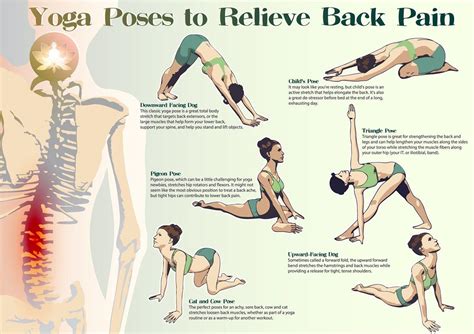Intro
Relieve sore back pain with gentle exercises and stretches, promoting back relief, lower back pain relief, and upper back pain relief through targeted movements and strengthening techniques.
Experiencing a sore back can be a debilitating and frustrating condition that affects millions of people worldwide. The causes of back pain can vary greatly, ranging from poor posture, muscle strain, and injury, to underlying medical conditions. Regardless of the cause, finding effective relief is crucial to restoring comfort and mobility. One of the most recommended and effective ways to alleviate back pain is through targeted exercises. Sore back exercises are designed to strengthen the muscles that support the spine, improve flexibility, and enhance posture, thereby reducing pain and preventing future episodes.
Engaging in regular physical activity, especially exercises tailored for back pain, can significantly improve the quality of life for those suffering from this condition. These exercises work by strengthening the core muscles, which include the abdominals and back muscles, to provide better support for the spine. Additionally, they help in improving flexibility and reducing muscle tension, which are common contributors to back pain. It's essential to approach these exercises with caution, especially if you're experiencing severe or chronic back pain, as some movements can exacerbate the condition if not performed correctly.
Understanding the importance of proper exercise techniques and the benefits they offer is the first step towards managing and relieving back pain. Before starting any exercise regimen, it's advisable to consult with a healthcare professional or a physical therapist who can provide personalized guidance based on the specific cause and severity of your back pain. They can help you develop a tailored exercise plan that meets your needs and ensures your safety while exercising. With the right approach and consistent practice, sore back exercises can offer significant relief and contribute to long-term back health.
Benefits of Sore Back Exercises

The benefits of engaging in sore back exercises are multifaceted and can lead to significant improvements in both physical and mental well-being. Some of the key benefits include:
- Strengthening of Core Muscles: Exercises like planks, bridges, and pelvic tilts help in strengthening the core muscles, which are essential for providing support to the spine and reducing pain.
- Improved Flexibility: Stretching exercises can improve flexibility, reducing stiffness and making it easier to perform daily activities without exacerbating the pain.
- Enhanced Posture: By strengthening the muscles that support the spine, these exercises can help improve posture, reducing the strain on the back and preventing future episodes of pain.
- Reduced Muscle Tension: Many exercises, including yoga and Pilates, focus on relaxing tense muscles, which can contribute to back pain relief.
- Improved Mental Health: Exercise is known to release endorphins, which are natural painkillers that can also boost mood and reduce stress, factors that can contribute to back pain.
Types of Sore Back Exercises
There are various types of exercises that can help alleviate back pain, each targeting different aspects of back health. These include: - **Stretching Exercises:** Designed to improve flexibility and reduce muscle tension. Examples include knee to chest stretches and cat-cow stretches. - **Strengthening Exercises:** Aimed at strengthening the core and back muscles to provide better support for the spine. Examples include planks and bird dog exercises. - **Low-Impact Aerobic Exercises:** Such as walking, swimming, and cycling, which can help improve cardiovascular health without putting excessive strain on the back. - **Yoga and Pilates:** These combine elements of stretching, strengthening, and breathing techniques to improve flexibility, strength, and posture.How to Perform Sore Back Exercises Safely

Performing sore back exercises safely is paramount to avoid exacerbating the condition. Here are some guidelines to follow:
- Warm-Up: Always start with a gentle warm-up to increase blood flow to the muscles and prepare them for exercise.
- Listen to Your Body: If you experience sharp pain or discomfort, stop the exercise immediately.
- Proper Technique: Ensure you're using the correct form and technique for each exercise to avoid straining your back further.
- Gradual Progression: Gradually increase the intensity and duration of your workouts to allow your muscles time to adapt and strengthen.
- Breathing: Focus on deep, controlled breathing, especially during stretching and strengthening exercises, to help relax and stabilize your muscles.
Common Sore Back Exercises
Some of the most common and effective exercises for relieving back pain include: 1. **Pelvic Tilt:** Lie on your back with your knees bent and feet flat on the floor. Tilt your pelvis upwards and then back down again, repeating the motion for several repetitions. 2. **Knee to Chest Stretch:** Lie on your back and bring one knee towards your chest. Hold for a few seconds before releasing and repeating with the other knee. 3. **Plank:** Start in a push-up position, with your hands shoulder-width apart and your body in a straight line from head to heels. Hold this position for as long as you can, aiming for at least 30 seconds. 4. **Cat-Cow Stretch:** Start on your hands and knees. Arch your back, lifting your tailbone and head towards the ceiling (like a cat). Then, round your back, tucking your chin to your chest and your tailbone towards the floor (like a cow). Repeat several times.Creating a Personalized Exercise Plan

Developing a personalized exercise plan is crucial for effectively managing back pain. This plan should be tailored to your specific needs, considering the cause and severity of your back pain, your current level of fitness, and any physical limitations you may have. Here are steps to create such a plan:
- Consult a Professional: Start by consulting with a healthcare provider or a physical therapist who can assess your condition and provide guidance.
- Set Realistic Goals: Based on your assessment, set realistic goals for what you want to achieve through your exercise plan, such as reducing pain or improving mobility.
- Choose Appropriate Exercises: Select exercises that are appropriate for your condition and goals. This may include a combination of stretching, strengthening, and aerobic exercises.
- Create a Schedule: Develop a schedule for your exercises, ensuring you have enough time for each session and allowing for rest days as needed.
- Monitor Progress: Regularly monitor your progress, adjusting your plan as necessary to ensure you're meeting your goals and not experiencing any adverse effects.
Overcoming Challenges
Sticking to an exercise plan can be challenging, especially when dealing with back pain. Here are some tips to help overcome common challenges: - **Stay Motivated:** Remind yourself of your goals and the benefits you've experienced so far. Celebrate small victories along the way. - **Find a Workout Buddy:** Exercising with a friend or family member can provide moral support and make the experience more enjoyable. - **Mix It Up:** Vary your exercises to avoid boredom and prevent plateaus. This can also help prevent overuse injuries. - **Be Patient:** Recovery and progress take time. Be patient with yourself and don't get discouraged by setbacks.Living with Back Pain

Living with back pain requires a multifaceted approach that includes not only exercise but also lifestyle adjustments and, in some cases, medical intervention. Here are some strategies for managing back pain effectively:
- Maintain a Healthy Weight: Excess weight can put additional strain on your back, so maintaining a healthy weight through a balanced diet and regular exercise can help alleviate pain.
- Improve Your Posture: Good posture can reduce the strain on your back. Make conscious efforts to stand and sit up straight, and avoid slouching or bending.
- Manage Stress: High levels of stress can exacerbate back pain. Engage in stress-reducing activities such as meditation, deep breathing exercises, or yoga.
- Get Enough Sleep: Adequate sleep is essential for healing and recovery. Ensure you're getting enough restful sleep each night.
Future Directions in Back Pain Management
The management of back pain is an evolving field, with ongoing research into new treatments and therapies. Some future directions include: - **Personalized Medicine:** Tailoring treatments to the individual, based on their genetic profile, lifestyle, and specific condition. - **Advanced Physical Therapies:** Incorporating technology, such as virtual reality and artificial intelligence, into physical therapy to make it more engaging and effective. - **Interventional Procedures:** Minimally invasive procedures that can provide relief for those with severe or chronic back pain.Conclusion and Next Steps

In conclusion, managing back pain effectively requires a comprehensive approach that includes sore back exercises, lifestyle adjustments, and potentially medical intervention. By understanding the benefits of these exercises, learning how to perform them safely, and creating a personalized exercise plan, individuals can take significant steps towards alleviating their back pain and improving their quality of life. Remember, it's essential to be patient and consistent, as progress may be gradual. Don't hesitate to reach out to healthcare professionals for guidance and support throughout your journey.
We invite you to share your experiences with sore back exercises and any tips you might have for managing back pain. Your insights can help others who are navigating similar challenges. Feel free to comment below, and don't forget to share this article with anyone who might benefit from the information provided.
What are the most common causes of back pain?
+Back pain can result from a variety of factors including poor posture, muscle strain, injury, and underlying medical conditions such as herniated discs or spinal stenosis.
How often should I exercise to relieve back pain?
+It's recommended to engage in back exercises at least 2-3 times a week, with rest days in between to allow your muscles time to recover and rebuild.
Can exercises alone cure back pain?
+While exercises can significantly alleviate back pain, they may not completely cure it, especially if the pain is due to an underlying medical condition. In such cases, a combination of exercises, lifestyle changes, and medical treatment may be necessary.
